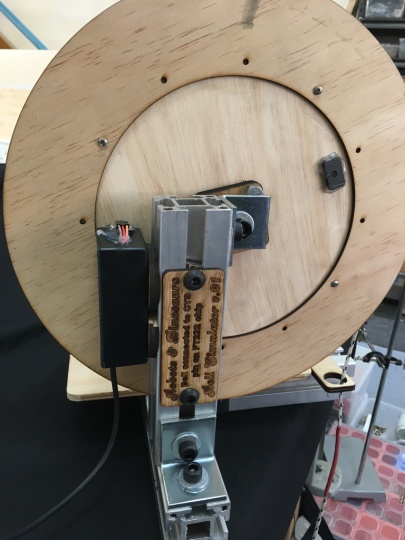I’ve recently gotten into Change Ringing, and helped a friend build a bell simulator from a broken bell that was laying around.
“Full Circle” bell ringing is a bit counter intuitive. Rather than having the mouth of the bell face down as you’d expect, the bells are over-balanced resting on a stop, so the slightest pull causes them to ring through 360* of travel.
Also, since the mass of the bell can be much more than the bellringer, they can’t start or stop the bell instantly, but instead can excerpt just enough force to comfortably shift maybe one position behind or one position ahead in the sequence.
The nifty consequence of this very mechanical limit, is that change ringing then becomes an exploration of the permutations possible with the sequence of bells. There’s a whole bunch of tasty mathematics in there, touching on graph theory, permutations, polyhedra, Hamiltonians, and much more.
Back to the hardware. Here’s what I came up with, it’s pretty cheap, and should be compatible with all major Campanology simulators like Abel & Virtual Belfry:

Note the ‘slider’ bar at the bottom can slide to allow the bell to rest stationary regardless of which side it was raised from
The main frame is made from the bulk aluminium extrusion I bought previously, and the bell is supported on some cheap 608 skate bearings held in lasercut wooden holders.

The wooden dowel used for the “stay” has been sized so that if the bell is rung up too vigorously, it breaks there, rather than anywhere else. (This much more import with the big bells, often weighing tons, as it means a $5 piece of wood is damaged, rather than the bearings, frame or bell itself).
The electrical parts needed are quite cheap, and cost only about $30:
- A USB to TTL serial adaptor: https://www.jaycar.com.au/arduino-compatible-usb-to-serial-adaptor-module/p/XC4464
- A hall effect sensor https://www.jaycar.com.au/arduino-compatible-hall-effect-sensor-module/p/XC4434
- To be really lazy, rather than solder the modules I used premade jumpers: https://www.jaycar.com.au/150mm-socket-to-socket-jumper-leads-40-piece/p/WC6026
Wiring is absurdly straight forward. 5V to 5V, GND to GND, and the signal from the sensor goes to the CTS signal on the serial.
All the electronics are mounted on the side. I used a cheap plastic box we had laying around the space. 
Once that’s done, a small magnet is hot-glued to the wheel so that it triggers the sensor at the resting (bell down) position.

The light on the hall effect sensor is very handy for tuning
Back to the computer. In Virtual Belfry, the bell is selected to use the COM port, and the CTS signal. It’s then just a matter of tuning the delay between the sensor firing and the bell striking.

Now the bell all set to practice ringing changes:

More portable than most steeples

Pingback: Quasimotor? A Robot Bell Ringer | Hackaday
Hi Gavin.
I’m aware that this thread is pretty old now but the subject is fresh for me and I believe you may be the person to clarify a couple of things for me.
I’m in the process of building a simulator in to our tower and was hoping to go for a much simpler version using an arduino and avoid the requirement for a laptop or PC.
Essentially, when the sensor sends a signal, the predefined offset timer starts and following the end of the timer, a sampled WAV file plays and continues playing until another input is seen when it restarts the file.
Can you please let me know if I’m talking rubbish?
Regards Steve
LikeLike
Hi Steven,
Good question. I think it’s totally doable, but I don’t know if the campanology simulators have an offset timer with a single fixed value, or if they simulate the dynamics more complexly. Assuming it’s a fixed time delay, then no problem.
I’d suggest a teensy microcontroller and teensy audio shield as hardware, then using the audio library here: https://www.pjrc.com/teensy/td_libs_Audio.html
Good luck with the project and keep me posted!
Cheers,
Gavin
LikeLike
Hi Gavin, Thanks for your reply.
Would it not be possible to set up profiles for different towers and run multiple bell options also?
The reason I ask is that I’m looking to develop a mobile system that can be used for practicing in different towers as an when necessary.
Essentially, a set of 6 sensors built on to brackets that could be fixed to the bell frames in pre defined positions via either Velcro straps or bungee cords. These would all feed in to a serial converter and Arduino module located in the belfry and would in an ideal world be connected via Bluetooth or RF connection to a stand alone speaker in the ringing chamber.
I’m trying to avoid the complexity of wires and permanent installations and don’t believe that the software of Simbell or similar is really of any huge benefit.
I was rather hoping to come up with a battery powered (rechargeable) system that, following initial set up (recording bells and setting offsets in to a profile) can then be taken to the tower, installed for a short period and then moved to another tower for their use.
Am I trying to reinvent the wheel here as I dont see this sort of system available currently on the market, I’m just trying to allow more ringers access to a very simple to use sim and hopefully introduce more people to the art without upsetting the neighbors.
I would appreciate your thoughts.
Steve
LikeLike